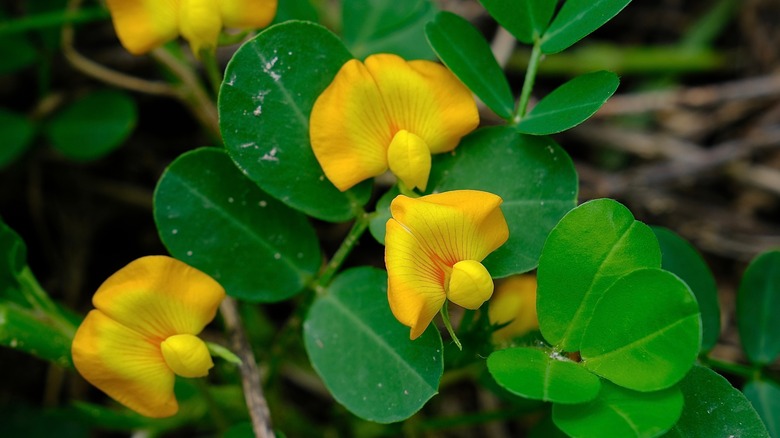Replace Your Grass With This Flowering Ground Cover For A Lawn Full Of Color
With the growing frequency of droughts and shifting of local climates, upkeeping a traditional lawn throughout the summer can be difficult, especially with restrictions on water and sprinkler systems. As a result, it may be worthwhile to look into alternative ground cover options for your yard. One possible solution is switching to perennial peanut, a rhizomal ground cover that is native to South America and, according to the U.S. Department of Agriculture, is not considered invasive in the United States. One advantage of making this change is that perennial peanut requires significantly less water compared to traditional grass lawns. Its deep roots can continue to drink water far beneath the surface, unlike the shorter roots of many other grasses. In this way, it's drought resistant and can survive purely off rainwater.
Another great feature of switching to perennial peanut is that it doesn't require frequent mowing. During rainy seasons, it only needs to be mowed about once every four weeks. This means far less maintenance for homeowners. Additionally, perennial peanut is excellent at helping to prevent soil erosion, making it perfect to plant on slopes or areas that wear down easily. Its strong root system can also reduce runoff and preserve the natural integrity of the landscape in your yard. Finally, perennial peanut is great to have near gardens, as it can fix nitrogen to the soil naturally, which reduces your need for synthetic fertilizers for both this ground cover and your garden plants. Moreover, its beautiful yellow flowers can attract pollinators to further support the healthy growth of any nearby crops.
How to plant perennial peanut
If the qualities of perennial peanut sound like a great alternative to you, then it may be time to make the switch. First, you'll need to remove your current grass using a tiller, allowing you to remove the turf in strips. You can compost these or dispose of them in yard waste bags. While perennial peanut can thrive without major lawn preparation, one way to give it a great start is to aerate the soil. There are a number of methods, but the easiest for your yard may be spike aeration for sandy soils or core aeration for clay soils.
One way to plant your perennial peanut is to sow already-started plugs. They are typically available in 4-inch pots that can be transplanted about 12 to 18 inches apart in your yard. This spacing will allow them to fill in once they are past the establishment phase. One consideration for purchasing started plugs is that it can be an expensive option for large yards, as you'll likely need dozens of plugs in order to cover your entire lawn.
Alternatively, you can purchase perennial peanut as seed, which may be cheaper depending on the size of your yard. Hancock Seed Company ships internationally and they recommend 1 pound of seed per 1,000 square feet of lawn. They sell a 5 pound bag for $225.00 which can be sown directly in the soil, and they take about 14-21 days to germinate.
Cautions for this alternative
While perennial peanut can be a great eco-friendly grass alternative in your yard, there are several cautions that you should keep in mind before committing to this option. One thing to know is that perennial peanut only grows well in warm climates. If you live in the United States and live north of South Carolina, it may not be the best option for your yard. Moreover, perennial peanut prefers sandy soil, so if you have poor-draining clay soil, it's likely not a good choice for a lawn replacement. On that same note, perennial peanut is a good option for places with low foot traffic. If you have pets or children that like to frequent your yard, you may want to look into a more hardy ground cover that can withstand more stress.
Something else to be aware of is that perennial peanut does take time to establish itself, even longer if planted from seed. During this time, your lawn may appear sparse or patchy. Be prepared to be patient while this ground cover develops. Once it grows in, your new ground cover should be rather low maintenance. Mowing every few weeks will help to maintain a tidy appearance and also encourage lateral spreading to fill in any spaces that may need coverage. Opting to let it grow wild may result in a more leggy or overgrown appearance, so be prepared for that result should you prefer that option instead.



